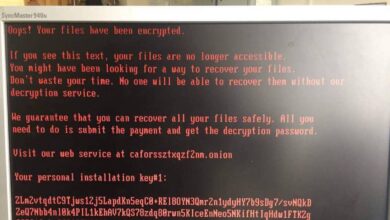
Employment Scams on the Rise What Can HR Do?
Employment scams on the rise what can hr do to mitigate them – Employment scams on the rise: what can HR do to mitigate them? It’s a question haunting HR departments everywhere. The internet, a tool meant to connect us, has become a breeding ground for sophisticated scams preying on desperate job seekers. From cleverly disguised phishing emails to fake job postings promising the world, the tactics are evolving constantly, leaving many feeling vulnerable and financially drained.
This isn’t just about lost money; it’s about the erosion of trust and the impact on morale within organizations. Let’s dive into the strategies HR can employ to combat this growing threat.
The sheer volume of employment scams is alarming. We’re seeing a surge in sophisticated techniques, making it harder than ever to distinguish legitimate opportunities from fraudulent ones. This isn’t just impacting individual job seekers; it’s damaging company reputations and creating a climate of suspicion. This post will explore the various types of scams, the red flags to watch out for, and, most importantly, the proactive steps HR can take to protect both their organizations and the candidates they engage with.
The Growing Threat of Employment Scams

The rise of online job searching has unfortunately created a breeding ground for employment scams. Job seekers, often eager to find work quickly, can become vulnerable targets for sophisticated and increasingly prevalent fraudulent schemes. These scams not only cause financial losses but also significant emotional distress and damage to an individual’s job search confidence. Understanding the trends and tactics employed by scammers is crucial for both individuals and HR departments to effectively mitigate this growing threat.
Recent Trends and Statistics on Employment Scams
Reports from organizations like the Federal Trade Commission (FTC) consistently show a significant increase in employment-related fraud. While precise, up-to-the-minute statistics fluctuate, the general trend reveals a concerning upward trajectory. Many victims report losing thousands of dollars to scammers posing as legitimate recruiters or employers. These losses aren’t just monetary; the time wasted, emotional toll, and damage to reputation are equally significant costs.
The sheer volume of reported scams highlights the need for increased awareness and proactive preventative measures. For example, the FTC reported a substantial increase in reported losses related to job scams in 2022 compared to previous years, with many victims falling prey to sophisticated phishing techniques and fake job postings on popular job boards.
Tactics Used by Employment Scammers to Target Job Seekers
Scammers employ a variety of manipulative tactics to lure unsuspecting job seekers. They often leverage the urgency and desperation inherent in a job search. Many scams begin with unsolicited emails or messages promising lucrative opportunities, often requiring minimal qualifications. These messages frequently contain links to fake websites or request personal information under the guise of application processing.
Scammers may also use social engineering techniques, building rapport with victims before ultimately requesting money or sensitive data. The use of fake company websites, impersonating well-known brands, is also a common tactic to enhance legitimacy and build trust.
Examples of Common Employment Scams
Several common types of employment scams plague the job market. Phishing emails, disguised as legitimate job offers, often contain malicious links or attachments designed to steal personal information. Fake job postings, often appearing on legitimate job boards, lure victims with promises of high salaries and minimal work. These postings typically lead to requests for upfront fees, advanced payments, or personal details.
Advance-fee scams, a particularly insidious type, require victims to pay money upfront for training, materials, or processing fees before any actual work begins – a payment that is never recouped. Another prevalent tactic is the use of fake job interviews conducted over video chat platforms. The interview itself may be a ruse to collect personal information.
Types of Employment Scams, Methods, and Red Flags
| Scam Type | Method | Red Flags | Example |
|---|---|---|---|
| Phishing Email | Unsolicited email with job offer, containing malicious links or attachments. | Unprofessional email address, grammatical errors, urgent requests for personal information, suspicious links. | An email promising a high-paying work-from-home position with a link to a website that looks suspiciously similar to a legitimate company’s site. |
| Fake Job Posting | Job advertisement on a legitimate job board, but leading to a fraudulent employer. | Unusually high salary, vague job description, requests for upfront payment, lack of company information. | A posting for a “Social Media Manager” requiring no experience, offering a six-figure salary, and requesting payment for “training materials.” |
| Advance-Fee Scam | Request for upfront payment for training, materials, or processing fees before starting work. | Requests for money before employment begins, vague promises of high returns, pressure to act quickly. | A “work-from-home” opportunity demanding a fee for “software licensing” before allowing access to the “work.” |
| Fake Interview Scam | Interview conducted remotely, often using video conferencing platforms, with the goal of collecting personal information. | Unusual interview process, vague questions, requests for sensitive information (SSN, bank details), lack of follow-up after the interview. | A video interview that focuses on personal details rather than job-related skills, and ends without a clear indication of next steps. |
HR’s Role in Prevention and Detection: Employment Scams On The Rise What Can Hr Do To Mitigate Them
The rise in employment scams presents a significant challenge for HR departments, demanding a proactive and multi-faceted approach to protect both the organization and its potential employees. HR’s role extends beyond simply processing applications; it encompasses a crucial responsibility in preventing and detecting fraudulent recruitment activities. Failure to do so can lead to financial losses, reputational damage, and legal liabilities.HR’s proactive role in mitigating employment scams is paramount.
It’s not enough to react to scams after they occur; a robust preventative strategy is essential. This involves implementing comprehensive policies and procedures, coupled with employee education and robust verification processes. The cost of reacting to a successful scam far outweighs the investment in preventative measures.
Proactive Measures to Prevent Employment Scams
Preventing employment scams requires a multi-pronged approach. This includes establishing clear internal policies outlining the organization’s recruitment process, specifying authorized communication channels, and detailing the steps involved in verifying applicant credentials. Regularly reviewing and updating these policies to reflect evolving scam tactics is critical. For example, a company could establish a policy requiring all communication to occur through official company email addresses and to explicitly state that the company will never request personal financial information during the application process.
Further, all job postings should be consistently published on the company website and well-known job boards to avoid confusion.
Educating Employees About Scam Awareness
A well-informed workforce is the first line of defense against employment scams. HR should implement comprehensive training programs to educate employees on identifying common scam tactics. This training should cover topics such as phishing emails, fake job postings, and suspicious requests for personal information. Role-playing scenarios and real-life examples of scams can make the training more engaging and effective.
For instance, training could involve showing examples of phishing emails containing suspicious links or requests for banking details, followed by a discussion on how to identify and report such communications. Regular refresher courses should be conducted to reinforce learning and address emerging scam techniques.
Verifying Job Applicants’ Credentials and Background Checks
Thorough verification of applicant credentials is essential in mitigating the risk of employment scams. HR should establish a robust process for verifying information provided by applicants, including education, employment history, and professional licenses. This can involve contacting previous employers, educational institutions, and professional licensing boards directly. Background checks, conducted by reputable third-party providers, can help identify any discrepancies or red flags in an applicant’s history.
For example, discrepancies between the applicant’s stated employment history and information obtained from previous employers should trigger further investigation. The process should be clearly documented, ensuring consistency and accountability. Furthermore, HR should be aware of the legal and ethical implications of background checks and ensure compliance with all applicable regulations.
Strengthening Recruitment Processes
Employment scams are becoming increasingly sophisticated, making it crucial for HR departments to fortify their recruitment processes. A robust and secure recruitment system acts as the first line of defense against these fraudulent activities, protecting both the company and potential candidates from harm. By implementing stringent verification procedures and clear communication protocols, HR can significantly reduce the likelihood of falling victim to employment scams.Building a strong recruitment process involves a multi-faceted approach, encompassing careful job posting verification, rigorous applicant screening, and secure communication channels.
This proactive strategy not only mitigates the risk of scams but also enhances the overall efficiency and effectiveness of the recruitment process. It fosters trust and transparency with applicants, contributing to a positive candidate experience.
Job Posting Verification and Applicant Screening, Employment scams on the rise what can hr do to mitigate them
Effective verification of job postings and applicant information is paramount. Before publishing any job advertisement, HR should meticulously verify the legitimacy of the posting, confirming its alignment with company policies and confirming the authenticity of the source. This might involve checking for inconsistencies in contact details, unusual payment requests, or grammatical errors. For applicant screening, HR should cross-reference information provided by applicants with publicly available data to verify credentials, employment history, and educational background.
This can involve utilizing background check services and conducting reference checks. Any discrepancies or inconsistencies should trigger further investigation before proceeding with the application. For example, if an applicant claims extensive experience in a specific field but lacks a verifiable track record, that should raise a red flag. Thorough background checks and reference verification are crucial steps in this process.
Secure and Transparent Communication
Maintaining transparent and secure communication channels with applicants is essential. All communication should occur through official company channels, avoiding personal email addresses or unofficial platforms. HR should establish clear guidelines on the information requested from applicants, ensuring they only ask for necessary details. Applicants should be educated on the company’s recruitment process and warned about potential scams.
For instance, the company should clearly state that it will never ask for upfront payments or sensitive personal information via email or text message. Using encrypted communication channels whenever possible further enhances security.
Steps to Improve Recruitment System Security
Implementing several security measures can significantly enhance the robustness of the recruitment system.
- Regularly update and patch the applicant tracking system (ATS) and other recruitment software to address known vulnerabilities.
- Implement multi-factor authentication (MFA) for all HR personnel accessing the recruitment system to prevent unauthorized access.
- Train HR staff on identifying and reporting potential employment scams. This training should include recognizing red flags, such as unusual requests for personal information or suspicious payment methods.
- Use strong, unique passwords for all recruitment-related accounts and encourage the use of password managers.
- Regularly review and update recruitment policies and procedures to reflect best practices and address emerging threats.
- Implement a system for tracking and reporting all recruitment-related communications, ensuring a complete audit trail.
- Conduct regular security audits of the recruitment system to identify and address potential weaknesses.
Utilizing Technology for Scam Detection

In today’s digital age, employment scams are becoming increasingly sophisticated. HR departments can no longer rely solely on manual processes to identify and prevent these fraudulent activities. Leveraging technology is crucial for enhancing the security of recruitment processes and protecting both the organization and potential candidates from falling victim to scams. The right tools can significantly improve efficiency and accuracy in identifying red flags and suspicious behavior.Technology plays a multifaceted role in combating employment scams.
It allows for automated screening of applications, verification of credentials, and analysis of communication patterns to detect inconsistencies and potential fraud. Furthermore, utilizing data analytics helps HR professionals identify trends and patterns in scam attempts, enabling proactive measures to be implemented. This proactive approach is far more effective than simply reacting to individual incidents.
Software and Tools for Scam Detection
Several software solutions and tools are available to help HR departments detect fraudulent activities. These range from applicant tracking systems (ATS) with built-in fraud detection capabilities to specialized anti-scam platforms. For instance, some ATS platforms incorporate features that analyze applicant resumes and online presence for inconsistencies or red flags, such as unusually high numbers of job applications or inconsistencies in stated experience.
Dedicated anti-scam platforms often leverage AI and machine learning to identify suspicious email addresses, phone numbers, or website domains commonly associated with fraudulent recruitment campaigns. These platforms can also monitor social media for suspicious activity related to the organization’s recruitment efforts. Additionally, background check services can provide more comprehensive verification of candidates’ credentials, including education and employment history.
Data Analytics for Identifying Scam Patterns
Data analytics provides a powerful tool for identifying patterns and trends in scam attempts. By analyzing data from various sources, including applicant tracking systems, email communications, and reported scams, HR departments can identify common tactics used by scammers. For example, analyzing the geographical location of applicants, the types of jobs targeted, and the communication channels used by scammers can reveal recurring patterns.
With employment scams on the rise, HR needs robust verification processes. One way to streamline this is by leveraging technology; for example, building secure internal systems using the innovative approaches described in this article on domino app dev, the low-code and pro-code future. Such efficient systems can help HR departments quickly flag suspicious applications and prevent costly mistakes, ultimately safeguarding the company from fraudulent hires.
This information can then be used to develop targeted prevention strategies. For instance, if a significant number of scams originate from a specific region or are targeting a particular job role, HR can implement stricter screening procedures for applications from that region or for that specific role. Similarly, identifying common phrases or communication patterns used by scammers can help train HR personnel to recognize and avoid these tactics.
Sophisticated analytics platforms can even predict future scam attempts based on identified patterns and trends.
Comparison of Anti-Scam Technologies
| Technology | Features | Limitations |
|---|---|---|
| Applicant Tracking System (ATS) with fraud detection | Automated resume screening, red flag identification, candidate verification | May require integration with other tools for comprehensive analysis; effectiveness depends on the sophistication of the ATS’s fraud detection capabilities. |
| Dedicated Anti-Scam Platform | AI-powered analysis of communication patterns, identification of suspicious domains and email addresses, social media monitoring | Can be expensive; requires ongoing maintenance and updates to stay effective against evolving scam tactics. |
| Background Check Services | Verification of education, employment history, criminal records | Can be time-consuming and expensive; may not detect all types of scams. |
| Data Analytics Platforms | Identification of patterns and trends in scam attempts, predictive modeling | Requires expertise in data analysis and interpretation; effectiveness depends on the quality and quantity of data available. |
Post-Scam Response and Recovery
Discovering that an employee, or even a prospective candidate, has fallen victim to an employment scam is a serious situation requiring immediate and compassionate action. Effective response protocols not only protect your organization’s reputation but also provide crucial support to those affected. A well-defined plan ensures consistency and minimizes further damage.The initial response to a suspected employment scam should be swift and methodical.
It’s crucial to balance the need for investigation with the need to support the affected individual. Remember, the victim is likely experiencing emotional distress, potentially including financial loss and embarrassment.
Responding to Suspected Employment Scams
The first step involves gathering all available information. This includes any communication with the suspected scammer (emails, text messages, documents), details about the job offer, and any financial transactions made. Document everything meticulously. Then, initiate an internal investigation to determine the extent of the scam and identify any vulnerabilities in your recruitment processes. This internal review should be conducted discreetly to protect the victim’s privacy and avoid causing further anxiety.
Supporting Victims of Employment Scams
Offering support to victims is paramount. This includes providing emotional support, guidance on reporting the scam to appropriate authorities, and assistance in recovering any lost funds if possible. Consider offering access to employee assistance programs (EAPs) or other mental health resources. Open communication and empathy are crucial. Avoid blaming the victim; instead, focus on helping them navigate this difficult situation.
For example, providing a quiet space to debrief, offering to help with the paperwork for reporting the scam, or simply listening to their concerns can make a significant difference.
Reporting Employment Scams to Authorities
Reporting the scam to the appropriate authorities is crucial. This usually involves contacting your local law enforcement agency and the Federal Trade Commission (FTC) in the United States, or the equivalent agency in your country. The FTC website provides valuable resources and reporting tools. Provide them with all the information you have gathered, including details about the scammer, the method of communication, and any financial transactions.
For instance, forwarding scam emails with headers intact provides crucial information for investigators. Additionally, inform the relevant regulatory bodies if the scam involves the misuse of your company’s name or branding.
A Step-by-Step Guide to Post-Scam Actions
- Secure all communication: Save all emails, texts, and documents related to the scam. Do not delete anything.
- Contact HR immediately: Report the incident to your HR department immediately.
- Gather information: Collect all relevant details about the scam, including the scammer’s contact information, the job offer details, and any financial transactions.
- Report to authorities: File a report with your local law enforcement agency and the FTC (or your country’s equivalent).
- Support the victim: Offer emotional support, resources, and assistance to the victim.
- Review recruitment processes: Conduct a thorough review of your recruitment processes to identify vulnerabilities and implement preventative measures.
- Inform employees: Consider educating your employees and candidates about common employment scams and how to avoid them.
Collaboration and Communication
Preventing and responding to employment scams requires a multi-faceted approach, and effective collaboration and communication are crucial components. A siloed approach leaves vulnerabilities, while open communication ensures swift action and minimizes potential damage. This section will explore the vital role of interdepartmental collaboration and employee awareness campaigns in building a robust defense against employment scams.Effective collaboration between HR, IT, and legal departments is paramount.
HR handles recruitment and employee relations, making them the first line of defense. IT possesses the technical expertise to identify and mitigate phishing attempts and other cyber threats. Legal provides guidance on compliance and potential legal ramifications. By sharing information and coordinating strategies, these departments can create a comprehensive system for scam prevention and response. For instance, IT can monitor email traffic for suspicious activity, alerting HR to potential scams before they reach candidates or employees.
Legal can then advise on appropriate actions to take, ensuring compliance with relevant regulations.
Interdepartmental Collaboration Strategies
A formal communication channel between HR, IT, and legal is essential. This could involve regular meetings, shared online platforms, or a dedicated task force to address scam-related issues. Clear protocols for reporting suspected scams, including escalation procedures, should be established. Regular training sessions for all three departments can ensure everyone is aware of the latest scam tactics and understands their roles in the prevention and response process.
This collaborative approach will significantly improve the organization’s ability to identify and neutralize threats. For example, if IT detects a phishing email mimicking the company’s branding, they can immediately inform HR to prevent candidates from falling victim. HR can then issue warnings and provide guidance, while Legal can assess the potential legal implications and guide the company’s response.
Communicating Scam Awareness to Employees and Candidates
Effective communication is key to raising awareness and empowering employees and candidates to identify and report potential scams. This requires a multi-pronged approach that utilizes various communication channels and formats. The goal is to make scam awareness training engaging, easily accessible, and memorable. Regular updates on evolving scam tactics are crucial to maintain vigilance.
Scam Prevention and Reporting Communication Plan
A well-defined communication plan should Artikel the channels, frequency, and content of scam awareness messages. This plan should include regular email updates, inclusion of scam awareness information in onboarding materials, presentations during team meetings, and the creation of easily accessible online resources, such as FAQs and informative videos. The plan should also detail the process for reporting suspected scams, ensuring that employees feel comfortable coming forward without fear of retribution.
Regular updates to the plan, reflecting evolving scam techniques, are critical to its effectiveness.
With employment scams on the rise, HR departments need robust security measures. One crucial aspect is verifying applicant information securely, often involving cloud-based systems. This is where understanding solutions like bitglass and the rise of cloud security posture management becomes vital for protecting sensitive data. By improving cloud security, HR can better safeguard against phishing attacks and other scams targeting job seekers and employees alike.
Example Company-Wide Email Campaign
Subject: Protecting Yourself from Employment ScamsBody:Hi [Employee Name],We’re writing to inform you about the increasing threat of employment scams. These scams can appear very convincing, often mimicking legitimate recruitment processes. To help protect yourself, please be aware of the following red flags:* Unusually high compensation offers.
- Requests for personal information before a formal interview.
- Unusual communication methods (e.g., only through text message).
- Pressure to act quickly without adequate time for consideration.
- Suspicious website addresses or email domains.
- Requests for payment of any kind.
If you receive a suspicious communication, please do not respond and immediately report it to [HR Contact Email Address or Phone Number]. We encourage you to forward any suspicious emails to [IT Security Email Address].Your safety and security are our top priority. By working together, we can effectively prevent employment scams from impacting our company.Sincerely,[HR Department Name]The tone of the email should be serious yet reassuring, emphasizing the company’s commitment to employee safety.
The call to action is clear and provides multiple reporting channels. The email uses a simple, easily understandable language, avoiding technical jargon. The email also incorporates visually appealing elements such as bolding important points and bullet points to ensure readability and to capture attention. A visually striking graphic could also be included, further highlighting the email’s importance.
Final Review
Protecting your organization and its future employees from employment scams requires a multi-pronged approach. It’s not enough to simply react to scams; a proactive, preventative strategy is key. By strengthening recruitment processes, leveraging technology, and fostering open communication, HR can create a safer and more trustworthy hiring environment. Remember, vigilance, education, and a robust system are your best defenses against this evolving threat.
Let’s work together to make the job search a safer experience for everyone.
Questions and Answers
What are some common red flags in a job posting that might indicate a scam?
Unusual urgency, requests for personal information early in the process, poor grammar and spelling, promises of unrealistic salaries or benefits, and lack of a company website or online presence are all major red flags.
What should an employee do if they suspect they’ve been a victim of an employment scam?
Immediately report it to your HR department and local law enforcement. Gather any evidence you have (emails, correspondence, etc.) and be prepared to share it with the authorities.
How can HR effectively communicate scam awareness to employees and candidates?
Use multiple channels – email campaigns, internal newsletters, training sessions, and even social media – to regularly share information about current scams and preventative measures.
Can HR use applicant tracking systems (ATS) to help mitigate scams?
Yes, many modern ATS platforms offer features to help identify and flag suspicious activity, such as automated checks for known scam email addresses or websites.





